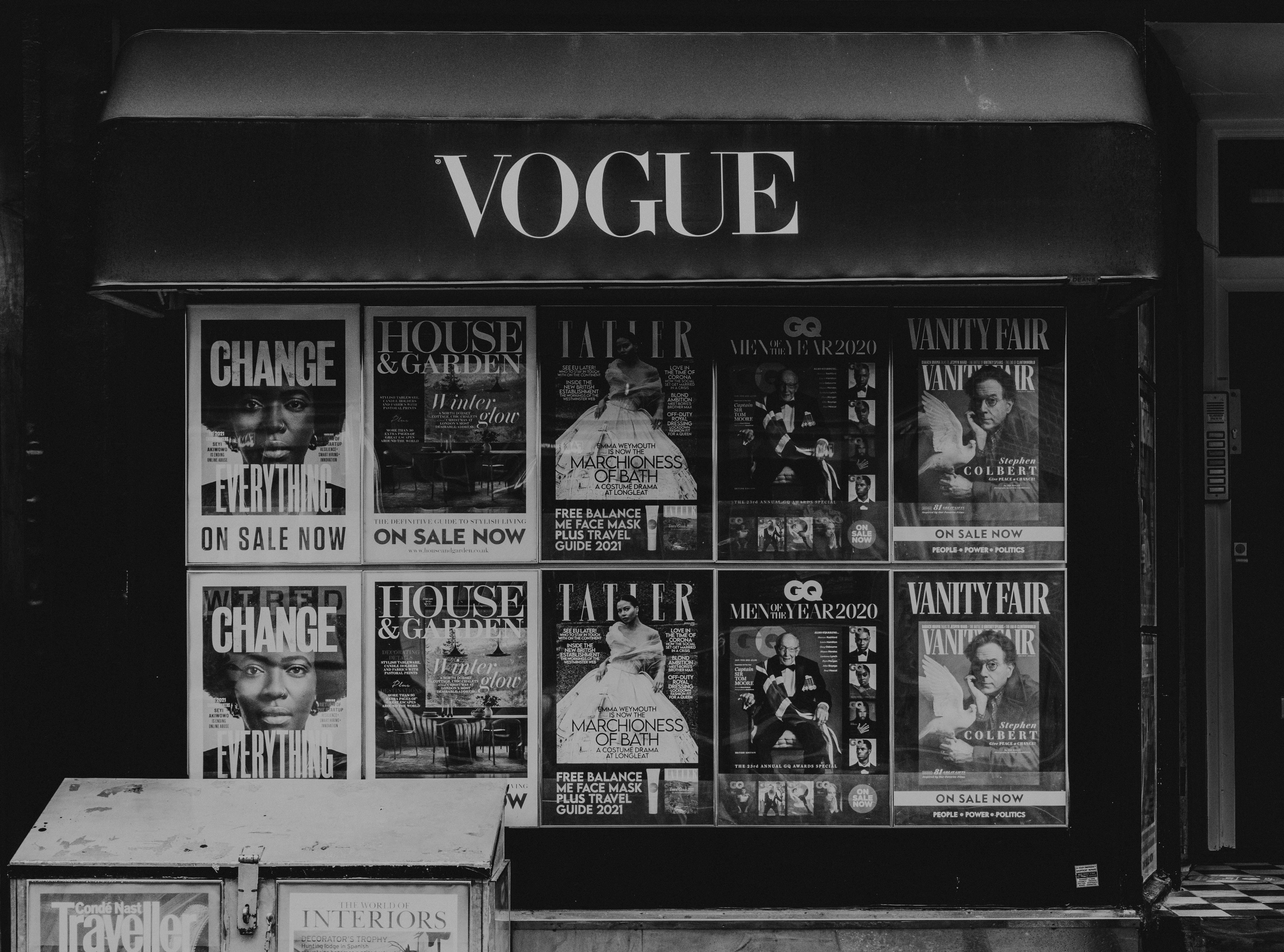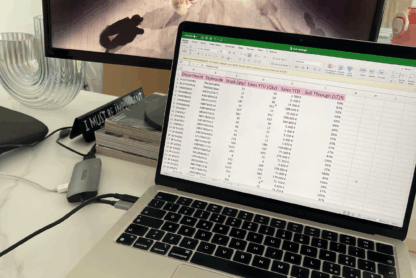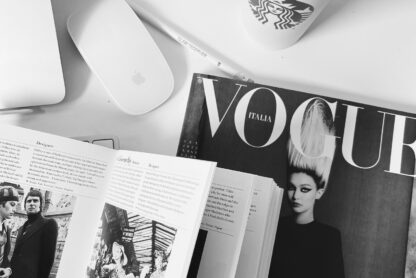Writing for fashion magazines is the ultimate dream of many fashion enthusiasts. The stories you read in magazines, the success of your favorite editors, and iconic fashion movies and TV shows (thank you Carrie Bradshaw from SATC and Jane Sloan from The Bold Type) may inspire you to pursue a career in fashion writing.
If this is your dream fashion career, then you are one step closer to making it a reality. In this article, I will share 3 essential steps to launch your career as a fashion writer. But first, let’s take a quick look at the role in case you are unfamiliar with the different types of fashion writers.
There are two types of fashion writers. First, those employed by the magazine (they are called in-house or staff writers or editors) and freelance writers.
A staff writer is someone who is full-time or part-time employed by a specific publication. They write content for all categories of the magazine, research, and pitch ideas to write articles on. Also, they conduct interviews for magazine content where necessary. They will also work closely with the sub-editors. This is to ensure word counts, deadlines, and overall writing tone are kept in line with the publication.
The second option to write for fashion magazines is to become a freelance writer.
This option is suitable for those who want to:
- Work in fashion remotely. You can work as a freelancer and work from anywhere. Communicate online with the editors about your piece and just deliver the final article via email.
- Write on the side while having another full-time job or while studying. Do this if you’re unable to commit to a full-time or part-time job.
For example, it is not uncommon for many stylists to be freelance writers as well. But even those who work in PR and marketing just to mention a few, could potentially write fashion articles. In fact, writing fashion articles does not only mean sharing style tips. There is also fashion sustainability, business, communication, influencer marketing, etc. So there are many different topics to cover. It includes styling tips to beauty reviews to catwalk reviews to what’s happening on the business side of the industry.
Writing fashion articles is also an option that considers who is at the beginning of their career in fashion. Given that even those who are still in school or just graduated can publish articles even just to add some experience to their CV and to showcase their knowledge of this industry.
I did this as well, though unconsciously. When I applied for my first internship in fashion, I had already started Glam Observer. I published some articles on careers and the business side of fashion. Being able to add Glam Observer to my CV despite it being only a blog read by a few at the time, gave me more confidence in the application phase even though I wasn’t applying for a job at a fashion magazine (in fact I applied for a fashion e-commerce internship).
Having my own fashion site has allowed me to be able to add some experience to my CV. It allowed me to add different skills. These include WordPress, Google Analytics, content management, and of course writing. Even though it wasn’t the reason why the company hired me, it sure helped as recruiters asked about my experience with my blog during the job interviews.
Now that we have seen all the benefits of becoming a fashion writer, let’s get to the point and see what are the 3 absolutely necessary steps to become a fashion writer and work with your favorite magazines.
The 3 Essential Steps to Launch Your Career as a Fashion Writer
1. Build a Writing Portfolio
Many believe that it’s absolutely necessary to take a fashion journalism course to become a fashion writer. The truth is that the #1 thing you really need to become a fashion writer is an excellent writing portfolio.
Your writing portfolio is a collection of your articles. In technical jargon, they are called “clips”, meant to be sent to magazines and editors to show your writing skills.
At this point, many beginner writers stop. They say “But how can I build a portfolio if I don’t have experience?”. To which I always reply that you can build one even without any previous experience.
It doesn’t matter if your articles have been published in Vogue or your personal blog, or if they are still only on your desktop.
Perhaps you will recall that you wrote some articles in the past as a hobby, and you can refresh them and send them to the editors. If you didn’t write any yet, you can write a few for the sake of building a portfolio.
Don’t be discouraged by the fact that you are a beginner writer. An excellent article is an excellent article and an editor knows it, so a short resume is something you should not be worried about.
In fact, you may not know it but for a fashion writer, a portfolio is even more important than a resume. Although a CV can show the recruiter other things about yourself, such as your skills other than writing, your educational background, etc., at the end of the day, the most important skill of a fashion writer is writing. So if you want to write for fashion magazines, you need to show them your writing. Showing is always better than telling.
Remember: A properly done writing portfolio beats any qualification and previous experience.
So if you have never published any article because you are still at the beginning of your career and you are starting from scratch, it is absolutely necessary that you start writing the articles to be included in your writing portfolio because it is the thing that will allow you to be able to publish your articles and work with magazines. I explain everything about how to build your writing portfolio in my online course The Fashion Writer Accelerator.
2. Pitch Editors
The most common mistake those who want to become fashion writers make is to apply only for job vacancies published online, but this is not a good strategy.
First, you should know that the best writing jobs are rarely posted online. Plus the competition is higher because everyone has access to these published offers.
Therefore, my advice for you is don’t just look online for jobs but try another, far more effective strategy: Pitching /cold-emailing directly all the fashion publications for which you would like to write.
Staff Writer
If you want to become a staff writer, fashion editor, or get a fashion writing internship, you have two options: apply to a job offer you found online or email the editors directly – that’s also a possibility and it’s far more effective than sitting around for months or years waiting for a job offer to get posted online.
Freelance Fashion Writer
If you want to become a freelance fashion writer, so you wouldn’t be a full-time employee at the magazine’s offices but a contributor. To do this, you need to pitch the editors directly with your article ideas. Every magazine includes a masthead page of its team that you can find in a print issue and in the digital version as well. Read it carefully, identify the editors working there, and email those who write about what you want to cover. For example, if you want to write about fashion, you should reach out to a fashion editor; if you are interested in covering beauty topics, you should contact a beauty editor. There are also feature editors, and those who write about travels, culture, etc. therefore you should be specific about the type of editor you are reaching out to depending on your article topic.
Niche Magazines
Another tip is don’t just consider the big names such as Vogue and Glamour. Reach out also to niche magazines and blogs because there is less competition there. Yes, it’s possible to write for the top fashion publications even at the beginning of your career. I see the examples of my students from the Fashion Accelerator Course who landed internships at Vogue Business, Marie Claire, CR Fashion Book, and more. However, when you are launching your career as a fashion writer, it’s important to consider as many publications as you can. You need to broaden your opportunities and increase your chances of landing a writing job.
Pitching is what can make or break your career as a fashion writer.
It doesn’t matter if you write amazing articles, if you don’t pitch correctly, no one will publish them. To get your work published in a fashion magazine, you have to learn how to sell your articles to the publications. This is exactly what I teach in my Fashion Writer Accelerator online course.
3. Expose your writing online
Besides an excellent writing portfolio and pitching, another thing that every fashion writer needs nowadays is an online presence.
When you pitch your articles to magazines, of course, you can send them just a PDF with your articles. But if you want to add something extra to your application and impress the editors, you should also consider building your online presence.
You need exposure and to make your name and work visible as much as possible. If you are a great writer but you don’t share your work with the world, and it stays on your desktop at worst and in one editor’s inbox at best, you are limiting your opportunities and your growth as a renowned fashion writer. And it’s not about fame and becoming the next Anna Wintour (unless you want to). It’s about building your name in the industry. Do this so that people start recognizing you more and more as a fashion writer. They will then acknowledge your work and be willing to work with you.
Sharing your articles online gives you more visibility as a writer.
On one hand, you can include your online platform links in your resume to show your work to recruiters. On the other hand, it allows you to get discovered by potential editors. You can receive writing opportunities without you having to look for them. This won’t probably happen on your first day as a fashion writer. As per a famous saying, first, you have to work for your name, and then the name starts working for you. But this is a good strategy for the long run. You don’t have to wait until you have several years of experience as a writer to build your online presence. Now, you can start making connections.
Having a strong online presence also conveys more professionalism. It’ll make you look like a serious fashion writer even if you are just starting your career and don’t have many articles. If this is your case, a fashion blog/website, a newsletter, or a LinkedIn/Instagram profile can make your lack of experience less noticeable and too big of a deal. When used effectively, these tools can be that one thing that makes even a beginner fashion writer stand out and give them a competitive edge.
This is how you can use them.
Launch a fashion blog/website
Building your own website/blog is super easy and fast to do. You can create one with Squarespace within just one hour for example. You don’t need to be tech-savvy to do this 😉 It doesn’t have to be anything complicated and fancy in terms of design, and there is no need to pay for an expensive template like some prestigious companies to make it look clean and professional. As you may know, Glam Observer started as just a blog and I always kept it simple while including all the necessary information. You also don’t need to have 50 articles already to make your website/blog worth it. A short presentation about yourself with a photo, a few articles, and your contact details is enough.
Start a newsletter
Newsletters have become increasingly popular in recent years, so you may want to consider this option. Having a newsletter can give you even more exposure as a writer than a blog/website and reach thousands of readers, among whom there are potential clients. And the best thing? You can create it for free. I for example use Substack for my Inside Fashion and 365 days of fashion newsletters.
Share your writing on social media
It may not come as an automatic thought when you think about showing your articles, but the truth is, social media has proven to be an effective tool for fashion writers.
For starters, as a fashion professional, you need a LinkedIn profile. It’s like your business card that presents you to other professionals in the industry and allows you to connect with editors and fellow writers. It’s important to leverage your connections to unlock writing opportunities. This way you can, for example, discover that a magazine is looking for writers because an editor you follow has published a post about it. Plus, you can share on LinkedIn the articles that you published in magazines. You can also share your personal blog/website. It allows you to give a glimpse into your writing style and attract recruiters/clients from fashion publications. Another good idea is to share the articles published by other editors/writers that you liked and explain why you like them.
Another social media platform you may have not thought of is Instagram. You can create a separate profile where you will be posting everything related to fashion and writing. Pro tip: Post a screenshot of your article in stories and save it in highlights. You can also create posts and reels for the feed where you can talk about the topics in the fashion industry that matter to you and share your articles.
Building your social media profile as a fashion writer is as simple as that. It doesn’t require much time and effort, but it can give you so much more visibility than if you didn’t have a social media account.
Fashion Blog
Nowadays, you have every tool at your disposal to share your writing with others. This is whether it is through a fashion blog, a newsletter, or social media. So, building a solid online presence for a fashion writer is a must.
OK, so now that you know what are the 3 fundamental things, you should know HOW are you going to implement these things. How you can create a writing portfolio. Learning how to choose what articles to add in there to grow your chances of getting the job. Also, learn how to create your own fashion website. It’s also important you learn to pitch publications and editors and what to write in these pitch emails. Moreover, learn about the business side so you can get your work published in more magazines. Then, you can make more money and find more publications to pitch, and so on and so forth.
And if you might be wondering if together with these 3 things you need to know something else, the answer is YES! There is a lot more you need to start a successful freelance writing career.
But don’t worry, I do have everything ready for you. So, within only a week, you have already started pitching publications. You’ve created your sample articles and fashion website. Also, if you work hard, probably you could be already working for some publications! I teach all these strategies in my online course The Fashion Writer Accelerator Course.








Me interesa el curso